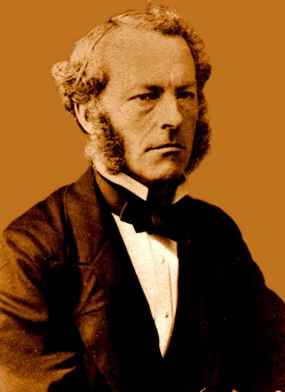George Gabriel Stokes (1819-1903)
 George Stokes' father, Gabriel Stokes, was the Protestant minister of
the parish of Skreen in County Sligo. His mother was the daughter of a minister
of the church so George Stokes's upbringing was a very religious one. Leaving
Skreen in 1832, George attended school in Dublin. In 1835, at the age of 16,
George Stokes moved to England and entered Bristol College in Bristol. Clearly
Stokes's talent for mathematics was shown during his studies at Bristol
College.
George Stokes' father, Gabriel Stokes, was the Protestant minister of
the parish of Skreen in County Sligo. His mother was the daughter of a minister
of the church so George Stokes's upbringing was a very religious one. Leaving
Skreen in 1832, George attended school in Dublin. In 1835, at the age of 16,
George Stokes moved to England and entered Bristol College in Bristol. Clearly
Stokes's talent for mathematics was shown during his studies at Bristol
College.
Stokes entered Pembroke College, Cambridge, in 1837. In Stokes's second year at Cambridge he began to be coached by William Hopkins, a famous Cambridge coach who played a more important role than the lecturers. In 1841 Stokes graduated as Senior Wrangler (the top First Class degree) in the Mathematical Tripos and he was the first Smith's prizeman. Pembroke College immediately gave him a Fellowship.
Stokes published papers on the motion of incompressible fluids in 1842 and 1843, in particular On the steady motion of incompressible fluids in 1842. After completing the research Stokes discovered that Duhamel had already obtained similar results but, since Duhamel had been working on the distribution of heat in solids, Stokes decided that his results were obtained in a sufficiently different situation to justify him publishing. Stokes then continued his investigations, looking at the situation where he took into account internal friction in fluids in motion. After he had deduced the correct equations of motion Stokes discovered that again he was not the first to obtain the equations since Navier, Poisson and Saint-Venant had already considered the problem.
In fact this duplication of results was not entirely an accident, but was rather brought about by the lack of knowledge of the work of continental mathematicians at Cambridge at that time. Again Stokes decided that his results were obtained with sufficiently different assumptions to justify publication and he published On the theories of the internal friction of fluids in motion in 1845. The work also discussed the equilibrium and motion of elastic solids and Stokes used a continuity argument to justify the same equation of motion for elastic solids as for viscous fluids. Perhaps the most important event in the recognition of Stokes as a leading mathematician was his Report on recent researches in hydrodynamics presented to the British Association for the Advancement of Science in 1846.
But a study of fluids was certainly not the only area in which he was making major contributions at this time. In 1845 Stokes had published an important work on the aberration of light, the first of a number of important works on this topic. He also used his work on the motion of pendulums in fluids to consider the variation of gravity at different points on the earth, publishing a work on geodesy of major importance On the variation of gravity at the surface of the earth in 1849.
In 1849 Stokes was appointed Lucasian Professor of Mathematics at Cambridge. In 1851 Stokes was elected to the Royal Society, awarded the Rumford medal of that Society in 1852, and he was appointed secretary of the Society in 1854. The Lucasian chair paid very poorly so Stokes needed to earn additional money and he did this by accepting an additional position to the Lucasian chair, namely that of Professor of Physics at the Government School of Mines in London. Stokes's work on the motion of pendulums in fluids led to a fundamental paper on hydrodynamics in 1851 when he published his law of viscosity, describing the velocity of a small sphere through a viscous fluid.
In 1854 Stokes theorized an explanation of the Fraunhofer lines in the solar spectrum. He suggested these were caused by atoms in the outer layers of the Sun absorbing certain wavelengths. However when Kirchhoff later published this explanation Stokes disclaimed any prior discovery. Stokes's career certainly took a rather different tack in 1857 when he moved from his highly active theoretical research period into one where he became more involved with administration and experimental work.
Stokes continued as secretary of the Royal Society from his appointment in 1854 until 1885 when he was elected President of the Society. He held the position of President until 1890. He was also president of the Victoria Institute from 1886 until his death in 1903. Stokes received the Copley medal from the Royal Society of London in 1893 and he was given the highest possible honor by his College when he served as Master of Pembroke College in 1902-3.
Stokes was a very important formative influence on subsequent generations of Cambridge men, including Maxwell. With Green, who in turn had influenced him, Stokes followed the work of the French, especially Lagrange, Laplace, Fourier, Poisson and Cauchy. This is seen most clearly in his theoretical studies in optics and hydrodynamics; but it should also be noted that Stokes, even as an undergraduate, experimented incessantly. Yet his interests and investigations extended beyond physics, for his knowledge of chemistry and botany was extensive, and often his work in optics drew him into those fields.

Connect with us
Contact us today